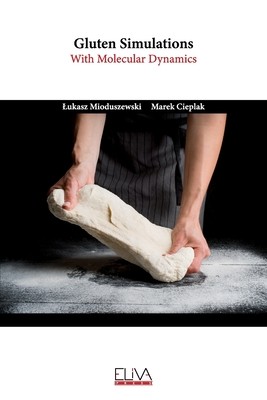
- We will send in 10–14 business days.
- Author: Marek Cieplak
- Publisher: Eliva Press
- ISBN-10: 1636483518
- ISBN-13: 9781636483511
- Format: 15.2 x 22.9 x 0.5 cm, softcover
- Language: English
- SAVE -10% with code: EXTRA
Reviews
Description
Gluten consists principally of intrinsincally disordered storage proteins (glutenins and gliadins) from wheat grains. During the breadmaking process these proteins form a network that is responsible for the extraordinary viscoelasticity of wheat dough that determine the quality of bread. This book sums up the pioneering simulations of gluten proteins, aimed for recreating their unique viscoelastic properties.
The computer simulations use the Dynamic Structure Based model, which enables molecular dynamics of thousands of amino acids. The corresponding time-dependent properties are studied through shear and axial deformations of the simulation box. The two types of deformation turn out to have a different impact on the proteins. Glutenins are shown to influence the mechanics of gluten much more than gliadins.
The measured quantities include the response force to the deformation, the number of entanglements and cavities, the mobility of residues, the number of the inter-chain bonds, etc. The dynamic shear modulus and critical strain are also calculated. The results are consistent with the existing ideas about gluten elasticity, e.g. the slip-bond theory which assumes that the gluten proteins can be treated as an interconnected network of polymers. The simulations emphasize the role of entanglements and hydrogen bonding.
Five different systems are simulated: in addition to gliadins, glutenins and gluten (a mixture of both), storage proteins from maize and rice are also considered. The last two constitute a control group, that (according to expectations) has weaker elasticity. This validates the methodology used in this approach.
EXTRA 10 % discount with code: EXTRA
The promotion ends in 19d.18:06:30
The discount code is valid when purchasing from 10 €. Discounts do not stack.
- Author: Marek Cieplak
- Publisher: Eliva Press
- ISBN-10: 1636483518
- ISBN-13: 9781636483511
- Format: 15.2 x 22.9 x 0.5 cm, softcover
- Language: English English
Gluten consists principally of intrinsincally disordered storage proteins (glutenins and gliadins) from wheat grains. During the breadmaking process these proteins form a network that is responsible for the extraordinary viscoelasticity of wheat dough that determine the quality of bread. This book sums up the pioneering simulations of gluten proteins, aimed for recreating their unique viscoelastic properties.
The computer simulations use the Dynamic Structure Based model, which enables molecular dynamics of thousands of amino acids. The corresponding time-dependent properties are studied through shear and axial deformations of the simulation box. The two types of deformation turn out to have a different impact on the proteins. Glutenins are shown to influence the mechanics of gluten much more than gliadins.
The measured quantities include the response force to the deformation, the number of entanglements and cavities, the mobility of residues, the number of the inter-chain bonds, etc. The dynamic shear modulus and critical strain are also calculated. The results are consistent with the existing ideas about gluten elasticity, e.g. the slip-bond theory which assumes that the gluten proteins can be treated as an interconnected network of polymers. The simulations emphasize the role of entanglements and hydrogen bonding.
Five different systems are simulated: in addition to gliadins, glutenins and gluten (a mixture of both), storage proteins from maize and rice are also considered. The last two constitute a control group, that (according to expectations) has weaker elasticity. This validates the methodology used in this approach.


Reviews